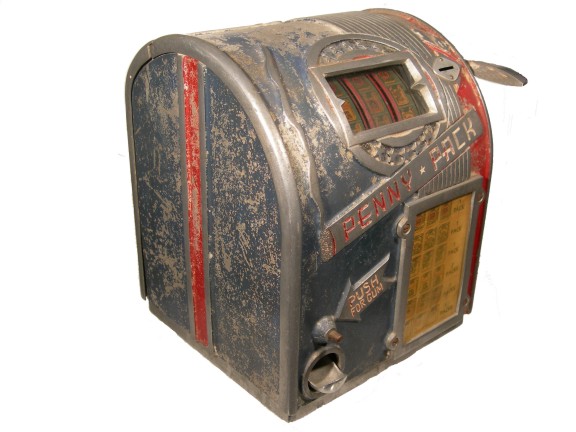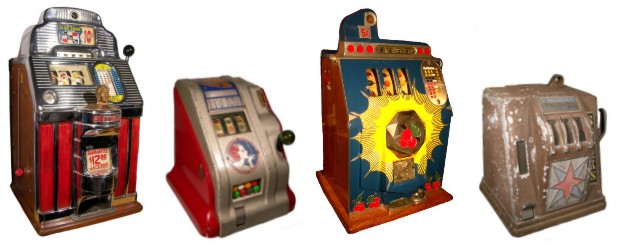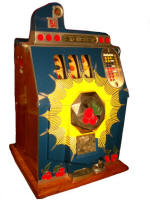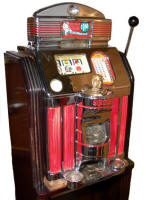|
Slot Machines and Trade Stimulators |
|
|
|
The market for these coin operated games was to keep a crowd of men entertained while at a saloon. This entertainment would keep the money flowing in for the saloon owner. Not only would the patrons be putting money in these machines, but they would also continue to purchase food and beverages. Most of the machines in saloons were trade stimulators. Before the fully independent coin operated machines were placed on the bar tops, many bar top machines required the attention and time of the bar tender, which was a waste of his time.2 One example of this is the Dice Trade Stimulator, where the bartender would have to count up the number the patron had on several dice, to determine if he had won or not. This early machine was popular but took up too much of the bartenders time. This game led to the development of fully independent trade stimulator machines. In order to distinguish between a slot machine and a trade stimulator, it is important to keep in mind the difference between gambling and amusement, which is a very fine line. A slot machine accepted money, and if the patron "won," the machine would pay out in money. However, with a trade stimulator, the patron would be "buying," for example, a ball of gum and the game part of it was for amusement only.3 However, the patron could win tokens, or cigars. Many times a trade stimulator is much smaller than a slot machine. As noted earlier, trade stimulators were often times placed right on top of a bar, to keep patrons entertained, so large machines would not have worked well in this situation. Trade stimulators have also been referred to as non-payout or miniature slot machines. Often times a trade stimulator will look like a slot machine, only smaller. Everyone knows what a slot machine is, but few know much about their history or that they are so closely related to trade stimulators. True slot machines have been around just as long as trade stimulators. It was between 1906 and 1915 when Herbert Mills, owner of Mills Novelty Company, began selling his classic Bell Slot Machine that they started to take off. After a brief cooling off period of slots, a strong backlash from Prohibition soon developed, which led to the Golden Age of Slots, from 1923 all the way until 1950. During the depression of the 1930's, nearly every place of business had a slot machine, from hotels, gas stations, drug stores, and soda fountains. Many of these businesses used the slot machine income as their means of surviving. It was in 1951 that the tides turned for slot machines. Congress passed the Johnson Act, which "abolished machines in states where they were illegal by preventing interstate shipment."4 At the same time many states passed anti-possession laws. By the 1960's Nevada was the only state with legal slot machines. In 1976 New Jersey legalized gambling, and in the 80's several more states passed gambling laws. Today they flourish across the country in many casinos, as well as the collectors home. Currently, Antique Warehouse has seven slot machines and six trade stimulators on display. Even though many trade stimulators are very similar to slot machines, each have their own sub-category under the coin operated category. Below you will be linked to either one or the other sub-category. Also, the bibliography is composed of several very interesting books related to coin operated machines, slots, and trade stimulators. By clicking on the link, you will be taken to Amazon.com, where the book can be purchased. 1 Bueschel, Richard M. Coin Machines, 1995. 2 Bueschel, Richard M. Vintage Trade Stimulators & Counter Games, 1997. 3 Kurtz, Bill. Slot Mahcines and Coin-Op Games, 1991. 4 Fey, Marshall. Slot Machines, 5th Edition, 1997. Bueschel, Richard M. Lemons, Cherries and Bell-Fruit-Gum, 1995. |
||
 |
 |
|
|
Click here to view our Slot Machines |
||
 |
 |
 |



